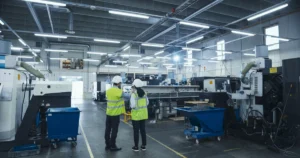Global EHS Deployment Without the Complexity
Managing EHS across five sites in one country is tough. Stretch that across borders, add new languages, regulations, and time zones, and most platforms start to crack. What looks “global-ready” in a demo often breaks down when it hits real-world complexity.
Benchmark Gensuite doesn’t gamble on that. It’s already running in over 150 countries, with 30+ languages supported natively — no forks, no code splits, no region-by-region rebuilds. That’s not marketing. That’s how the platform is built: one version, one database, fully aligned across every site and every user.
If your EHS software treats every international rollout like a new build, you’re not scaling — you’re stuck rebuilding.
Where Global EHS Gets Complicated Fast
The success or failure of global EHS deployment depends on how well your system performs where the real work happens — on the floor, in the field, and in local regulatory environments.
Here’s what global teams deal with on the ground:
- In Brazil, authorities expect environmental reports, incident records, and regulatory filings in Portuguese to carry legal effect. Using imprecise or automated translations during inspections or audits can raise questions about compliance.
- In Germany, privacy laws under GDPR apply broadly to EHS reports. Near-miss or incident records that include names, locations tied to a person, or health and medical details qualify as personal data. Mishandling this data risks noncompliance.
- In China, the primary obstacle is infrastructure and data localization. Strict cybersecurity and cross-border data laws require in-country hosting and ICP licensing — processes that can take months for Western-hosted platforms.
These aren’t edge cases. This is everyday EHS for multinational organizations, and most platforms aren’t built to handle it. If your current system relies on manual translations, duplicated sites, or region-specific patches, it’s not ready for global scale.
What True Global Deployment Looks Like Side by Side
Let’s see how different platforms stack up where it counts.
| Feature | Benchmark Gensuite | Typical Platform |
|---|---|---|
| Languages Supported | 30+ languages, maintained in-house | 8–12 core, others via third-party translation |
| Mobile Language Options | Fully localized mobile apps, not just UI labels | Desktop-focused, mobile often English-only |
| Version Management | Single instance, real-time updates across all regions | Region-based forks or staggered versioning |
| Localization Setup | Native language toggles, no dev needed | Requires separate implementation or vendor contract |
| Multilingual Training & Support | Built-in tooltips, videos, and help desk in local languages | Often English-first, with regional delay |
This comparison shows the structural differences. But what does it look like when a global rollout actually works at scale, under pressure, and on deadline?
What a Global EHS Rollout Actually Looks Like
For Tropicana Brands Group, the goal was clear: standardize EHS operations across international sites, onboard over 2,000 employees, and launch a global KPI framework — in just seven weeks.
Most systems would need twice that time just to get regional teams aligned. But Benchmark Gensuite was built for exactly this.
One Platform. One Plan. Seven Weeks.
- 12 global KPIs were configured and rolled out from the start.
- 2,400 employees were onboarded using mobile apps, in-app guides, and localized training materials.
- The same system ran across all sites — no regional versions, no patchwork deployments.
Site leaders got real-time visibility. Field teams could log concerns from their phones in under a minute. Corporate had access to scorecards that connected safety performance directly to business goals.
Data-Driven, Not Just Data-Rich
Concern Reporting played a major role in Tropicana’s cultural shift. Reports didn’t just get filed — they got escalated, investigated, and resolved. Nearly 75% of submissions triggered follow-up actions. Leadership saw risks faster, and frontline employees saw that their input mattered.
The mobile app made it simple: employees logged reports in the field, during inspections, or at shift change — with instant syncing and translation. Nothing got lost waiting for desktop access.
The Result
- Fully functioning global EHS system deployed in 7 weeks
- 12 global KPIs tied to business plans
- 2,400 employees onboarded across markets
- Unified platform replacing fragmented systems
This wasn’t a pilot — it was a full-scale global rollout done right, fast, and built to last.
Why One Version Matters More Than You Think
Legacy systems often promise flexibility, but that flexibility comes at a cost: fragmentation. You end up with multiple systems, inconsistent data, and version delays. When you need a global view, that fragmentation becomes a barrier.
Benchmark Gensuite avoids that by running every customer on the same codebase. That means:
- Updates roll out globally and simultaneously.
- Sites configure local workflows without changing the backend.
- Dashboards, reports, and KPIs stay aligned across borders.
No forks. No silos. No waiting six months for features to catch up across regions.
Built for the Field. Proven Across Borders.
Global EHS doesn’t live in the office — it lives in the field, where Wi-Fi drops, languages change, and safety can’t wait. If your platform can’t support offline inspections in Indonesia, onboarding in Spanish, and real-time visibility in the U.S., without IT intervention — it’s not built for global work.
- Mobile-first, with full offline workflows
- 30+ languages supported, desktop and mobile
- Translated reports synced automatically, audit-ready in seconds
No translation lag. No version splits. No silos. Just one platform, working in real time, everywhere.
Ready to deploy once — and get it right across every site? Request a demo today.
FAQ
How do global companies manage EHS across multiple countries?
By using a unified platform with built-in localization, global companies can standardize EHS processes while meeting regional needs. Benchmark Gensuite supports 30+ languages and configurable workflows, enabling compliance without complexity.
What languages does Benchmark Gensuite support?
The platform supports over 30 languages including Spanish, French, German, Mandarin, Portuguese, and Hindi — both in the core UI and mobile app.
Can field users submit safety incidents in their native language?
Yes. Benchmark’s mobile-first UX allows users to submit reports, concerns, and audits in their native language, while corporate teams access real-time translations.
What’s the advantage of no-version global platforms?
Unlike legacy systems, Benchmark Gensuite is versionless — updates roll out globally without disruption, keeping every site and user on the latest tools instantly.
How does Benchmark Gensuite handle regulatory differences across regions?
The platform allows sites to configure forms, workflows, and reporting fields to meet local regulatory requirements, without spinning up separate systems. Whether it’s OSHA in the U.S., REACH in Europe, or IBAMA in Brazil, teams stay compliant using one centralized platform.
Is Benchmark Gensuite secure enough for countries with strict data privacy laws?
Yes. The platform includes role-based access, field-level data controls, and support for regional data residency requirements. It’s designed to meet global standards like GDPR and PIPL while still allowing corporate teams to view aggregated, anonymized metrics across borders.



